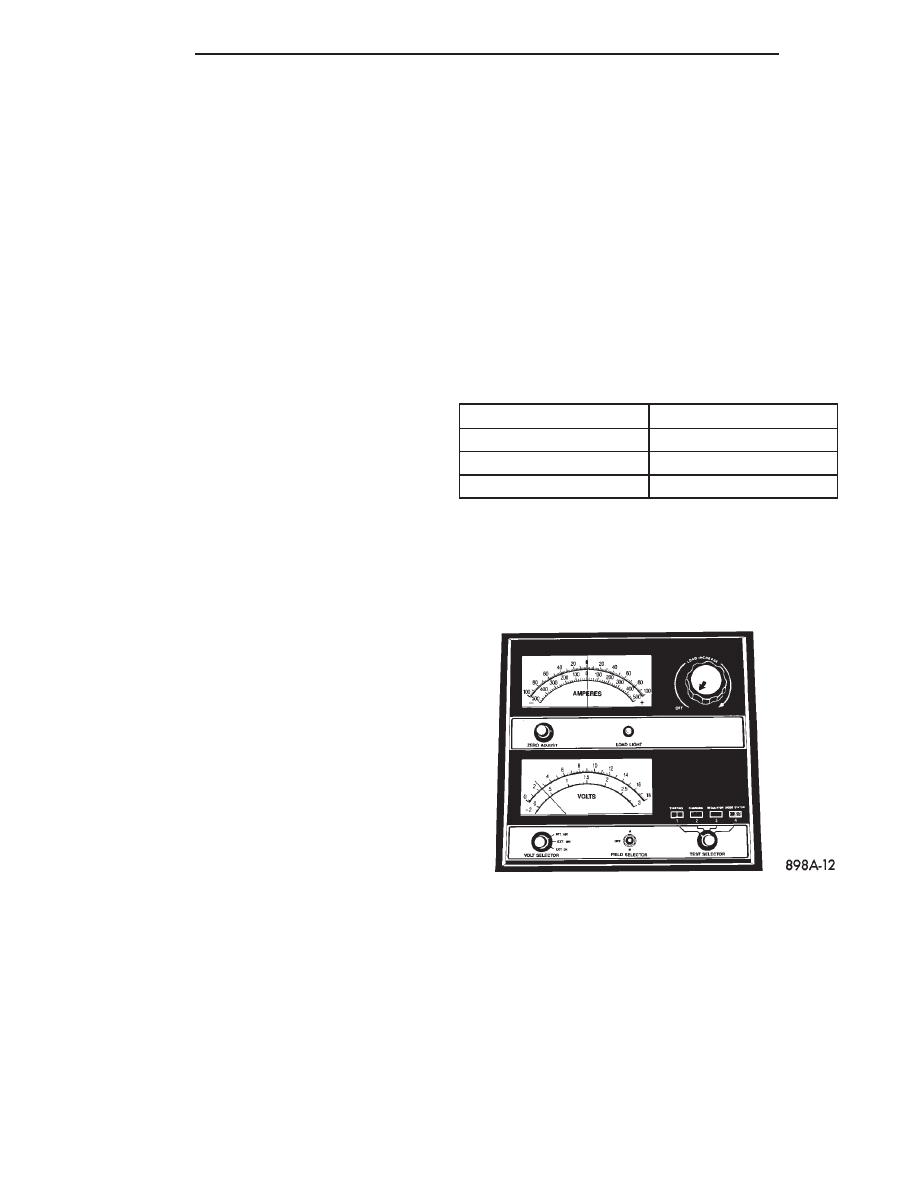Chrysler New Yorker. Manual - part 55

SERVICE PROCEDURES
BATTERY CHARGING
WARNING:
DO NOT CHARGE A BATTERY THAT
HAS EXCESSIVELY LOW ELECTROLYTE LEVEL.
BATTERY
MAY
SPARK
INTERNALLY
AND
EXPLODE. EXPLOSIVE GASES FORM OVER THE
BATTERY. DO NOT SMOKE, USE FLAME, OR CRE-
ATE SPARKS NEAR BATTERY. DO NOT ASSIST
BOOST OR CHARGE A FROZEN BATTERY. BAT-
TERY CASING MAY FRACTURE. BATTERY ACID IS
POISON, AND MAY CAUSE SEVERE BURNS. BAT-
TERIES CONTAIN SULFURIC ACID. AVOID CON-
TACT WITH SKIN, EYES, OR CLOTHING. IN THE
EVENT OF CONTACT, FLUSH WITH WATER AND
CALL PHYSICIAN IMMEDIATELY. KEEP OUT OF
REACH OF CHILDREN.
CAUTION: Disconnect the NEGATIVE battery cable
remote terminal first before charging battery to
avoid damage to electrical systems. Do not exceed
16.0 volts while charging battery. Refer to the
instructions supplied with charging equipment
NOTE: The battery cannot be refilled with water, it
must be replaced.
A battery is considered fully charged when it will
meet all the following requirements.
• It has an open circuit voltage charge of at least
12.4 volts. Refer to Battery Open Circuit Voltage
table.
• It passes the 15 second load test, refer to the
Load Test Temperature chart.
• The built in test indicator dot is GREEN (Fig.
4).
Battery electrolyte will bubble inside of battery
case while being charged properly. If the electrolyte
boils violently, or is discharged from the vent holes
while charging, immediately reduce charging rate or
turn off charger. Evaluate battery condition. Battery
damage may occur if charging is excessive.
Some battery chargers are equipped with polarity
sensing devices to protect the charger or battery from
being damaged if improperly connected. If the bat-
tery state of charge is too low for the polarity sensor
to detect, the sensor must be bypassed for charger to
operate. Refer to operating instructions provided
with battery charger being used.
CAUTION: Charge
battery
until
test
indicator
appears green. Do not overcharge.
It may be necessary to jiggle the battery or vehicle
to bring the green dot in the test indicator into view.
After the battery has been charged to 12.4 volts or
greater, perform a load test to determine cranking
capacity. Refer to Battery Load Test in this Group. If
the battery passes the load test, return the battery to
use. If battery will not endure a load test, it must be
replaced. Properly clean and inspect battery hold
downs, tray, terminals, cables, posts, and top before
completing service.
CHARGING COMPLETELY DISCHARGED BATTERY
The following procedure should be used to recharge
a completely discharged battery. Unless procedure is
properly followed, a good battery may be needlessly
replaced.
(1) Measure the voltage at battery posts with a
voltmeter accurate to 1/10 volt (Fig. 10). If below 10
volts, charge current will be low, and it could take
some time before it accepts a current in excess of a
few milliamperes. Such low current may not be
detectable on amp meters built into many chargers.
(2) Connect charger leads. Some chargers feature
polarity protection circuitry that prevents operation
unless charger is connected to battery posts correctly.
A completely discharged battery may not have
enough voltage to activate this circuitry. This may
happen even though the leads are connected properly.
(3) Battery chargers vary in the amount of voltage
and current they provide. For the time required for
the battery to accept measurable charger current at
various voltages, refer to Charging Rate Chart. If
charge current is still not measurable after charging
BATTERY CHARGING RATE
VOLTAGE
HOURS
16.0 VOLTS OR MORE
UP TO 4 HOURS
14.0 TO 15.9 VOLTS
UP TO 8 HOURS
13.9 VOLTS OR LESS
UP TO 16 HOURS
Fig. 10 Voltmeter Accurate to 1/10 Volt (Connected)
8A - 8
BATTERY
300M